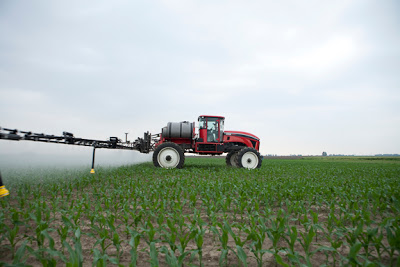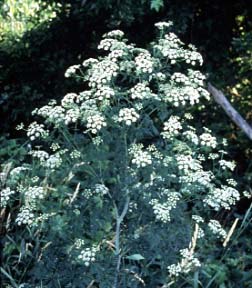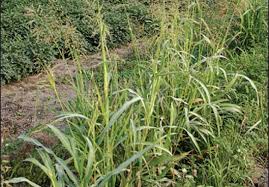The Knox County Master Gardener Volunteers are piloting a seed exchange at the Centerburg Public Library. Check out the details below.
Month: May 2018
BQA Training
Corn Growth Stage and Postemergence Herbicides
by: Aaron Hager, University of Illinois

The labels of most postemergence corn herbicides allow applications at various crop growth stages, but almost all product labels indicate a maximum growth stage beyond which broadcast applications should not be made, and a few even a state minimum growth stage before which applications should not be made. These growth stages are usually indicated as a particular plant height or leaf stage; sometimes both of these are listed. For product labels that indicate a specific corn height and growth state, be sure to follow the more restrictive of the two. Application restrictions exist for several reasons, but of particular importance is the increased likelihood of crop injury if applications are made outside a specified growth stage or range. The following table lists the maximum corn growth stage for broadcast application of several postemergence corn herbicides. Be sure to constult the respective product label for additional precautions or restrictions.
Table 1. Postemergence herbicide application timings based on corn growth stage(s).
| Herbicide | Maximum corn heights and/or growth stagesa |
| 2,4-D | Broadcast before corn exceeds 8” tall; use drop nozzles when corn is taller than 8”. |
| Accent Q | Broadcast up to 20” tall or through the V6 stage. Apply with drop nozzles when corn is 20–36” tall or before the V10 stage. |
| Anthem Maxx | Apply from corn emergence through the V4 (visible fourth leaf collar) stage. |
| Armezon Pro | Apply from corn emergence to the 8-leaf stage or 30” tall. Use directed applications when corn is 12–30” tall. |
| Atrazine | Apply before corn exceeds 12” tall. |
| Basagran | No height specified on label. |
| Basis Blend | Apply to corn from spike through 2 collar stage. Do not apply to corn having 3 fully emerged collars or over 6” tall. |
| Cadet | Apply until corn is 48″ tall or prior to tasseling. |
| Callisto/Callisto GT | May be applied to corn up to 30” tall or up to the 8-leaf stage. |
| Callisto Xtra | Apply before corn exceeds 12” tall |
| Capreno | Broadcast applications may be made to corn from the 1-leaf collar stage up to 20” tall. Do not apply if corn is more than 20” tall or exhibiting 7 or more leaf collars. |
| Clarity or Banvel | Apply between corn emergence and the 5-leaf stage or 8” tall; apply 0.5 pt/A rate when corn is 8 to 36” or if 6th leaf is emerging, or if 15 days prior to tassel emergence. Do not apply when soybean are growing nearby if: 1) corn is more than 24” tall, 2) soybean are more than 10” tall, 3) soybean have begun to bloom. |
| DiFlexx | Apply broadcast to corn from spike through V10 growth stage or 36” tall, whichever occurs first. |
| DiFlexx Duo | Apply broadcast to corn from emergence up to, but not including, V7 or 30” tall, whichever occurs first. Can be applied as a directed spray from V7 through V10, up to 36” tall corn, or up to 15 days prior to tassel, whichever occurs first. |
| Enlist One/Duo | Apply when corn is no larger than V8 or 30” tall, whichever is more restrictive. Directed applications can be made to corn up to 48” tall. |
| Glyphosate (glyphosate-resistant corn) | Apply broadcast through the V8 stage or until corn reaches 30” tall. Use drop nozzles for applications to corn 30–48” tall. |
| Halex GT (glyphosate-resistant corn) | Apply to corn up to 30″ tall or the 8-leaf stage. |
| Harmony SG | Apply to 2–6 leaf corn with 1–5 collars or up to 16” tall. |
| Harness Max | Apply until corn reaches 11” tall. |
| Hornet WDG | Apply broadcast until corn reaches 20” tall or V6 stage. Apply with drop nozzles to corn up to 36” tall. |
| Impact/Armezon | Can be applied up to 45 days before harvest. Do not apply Armezon past the V8 growth stage. |
| Impact Z | Apply before corn exceeds 12” tall. |
| Laudis | Apply up to the V8 growth stage. |
| Liberty (glufosinate-resistant corn) | Broadcast until corn at the V6 growth stage. Use drop nozzles for up to 36” tall. |
| Marksman | Apply between corn emergence and the 5-leaf or 8” height stage. |
| Moxy | Apply prior to tassel emergence. |
| NorthStar | Broadcast applications are made when corn is between 4 –20” tall (V2–V6). Use directed applications when corn is 20–36” tall. |
| Permit | Can be applied from spike through layby. |
| Realm Q | May be broadcast applied to corn up to 20” tall or exhibiting 6 leaf collars. |
| Require Q | Apply to corn 4–20” tall. Do not apply to corn exhibiting 7 or more leaf collars. |
| Resolve Q | Do not apply to corn taller than 20” or exhibiting 7 or more leaf collars. |
| Resource | Apply to corn from the 2-leaf through 10-leaf stage. |
| Revulin Q | Do not apply to corn taller than 30” or that exhibits 8 or more collars. |
| Solstice | May be applied broadcast up to the V8 growth stage or 30” tall. |
| Starane Ultra | Apply broadcast to corn with up to 5 fully exposed leaf collars (V5). |
| Status | Can be applied to corn between 4” (V2) and 36” (V8) tall. |
| Steadfast Q | Apply to corn up to 20” tall and exhibiting up to 6 leaf collars. |
| Stinger | Apply to corn from emergence through 24” tall. |
| Yukon | Apply broadcast or with drop nozzles to corn from spike to 36” tall. Drop nozzles are recommended when corn exceeds 20”. |
| Zemax | May be applied after corn emergence until plants reach 30” tall or up to the V8 stage. |
a When maximum application timings are indicated by two corn growth stages, follow the most restrictive of the two.
Young Corn with Wet Feet: What Can We Expect?
by: Alexander Lindsey, Peter Thomison, Steve Culman, OSU Extension

Around the state, there are many corn fields with young plants with standing water due to the intense storms that have passed through. But what are the long-term effects of standing water on emerged corn? Preliminary data from two locations in Ohio in 2017 suggests that as long as a sidedress N application can be made following the waterlogging, yield loss may be minimal if the waterlogged conditions lasted 4 days or less.
Waterlogging can affect yield in two main ways: 1) damage to the plant physiologically, and 2) N loss through denitrification or leaching. The presence of standing water in the field can affect corn yield by inhibiting growth and restricting ear development (which occurs during vegetative stages). Standing water also reduces the amount of oxygen in the soil, which can cause nitrate in the soil to be converted to forms that are unavailable for plant uptake and may be lost to the environment. Trials in Ohio conducted in 2017 suggest that corn can survive waterlogged conditions for 4 days or less in the early vegetative stages (V4-5) with minimal impact on yield if a sidedress application can be made after the soil has dried. However, if a sidedress application cannot be made on corn waterlogged for 4 days or more, a yield penalty of 13 to 45% was observed. When waterlogging extended to 6 days even with a sidedress N application, a reduction in yield of 9-33% was observed compared to corn flooded for 4 days or less. These results are consistent with past research (10-50% yield loss if flooded longer than 2 days), but will be repeated in 2018 for validation.
Continue reading Young Corn with Wet Feet: What Can We Expect?
Ohio Noxious Weed Identification – Week 16 Poison Hemlock
 Poison Hemlock
Poison Hemlock
Family: Parsley, Apiaceae.
Habitat: Wet sites, gardens, roadsides, wastelands, pastures, and meadows.
Life cycle: Biennial, forming a rosette the first year and producing flowers and seed in the second.
First Year Growth Habit: Basal rosette of finely divided leaves with a pungent odor.
Second-Year Growth Habit: 2-7 feet tall, branched plant with flowers.
Leaves: Alternate, pinnately compound, finely divided, toothed, and glossy green.
Stems: Branched, waxy with purple blotches; hollow between nodes and grooved.
Flower: June – August (second year). Clusters of small white flowers with 5 petals in a loose, umbrella-like cluster, 2-7” across.
Root: Fleshy taproot.
Similar plants: During the first year, poison hemlock resembles wild carrot, but has a strong, pungent odor. Further, young leaves of wild carrot are more finely divided and its stem is hairy. At maturity, poison hemlock can be difficult to distinguish from water parsnip and water hemlock. Look for purple blotches on the stem to identify poison hemlock. Water hemlock (Cicuta maculata), which is also highly poisonous, has a magenta-streaked stem and lanceolate leaflets with sharply-toothed edges. Water parsnip (Sium suave) is not poisonous and has toothed lanceolate leaflets.
The problem is….This plant is highly poisonous to both humans and animals. Poison hemlock is a large and impressive plant which has been planted as an ornamental in some areas. It grows quickly in fertile soils.
Continue reading Ohio Noxious Weed Identification – Week 16 Poison Hemlock
Soybean Plant Population Study – Plot 3 Planted
May 17 Knox County Soybean Plant Population Trial # 3 in the ground!! Thanks to Jim Braddock.
2018 Knox County Plant Population Trial #3
125,000 Seeds/Acre
145,000 Seeds/Acre
165,000 Seeds/Acre
185,000 Seeds/Acre
Each rate replicated 3 times.
2017 Knox County Plant Population Study Results are shown in the table below.
This research plot was included in the statewide eFields Report linked below.
Soybean Plant Population Study – Plot #2 Planted
May 8 Knox County Soybean Plant Population Trial # 2 in the ground!! Thanks to Jim Braddock.
2018 Knox County Plant Population Trial #2
125,000 Seeds/Acre
145,000 Seeds/Acre
165,000 Seeds/Acre
185,000 Seeds/Acre
Each rate replicated 3 times.
2017 Knox County Plant Population Study Results are shown in the table below.
This research plot was included in the statewide eFields Report linked below.
Ohio Noxious Weed Identification – Week 15 Johnsongrass
 Johnsongrass
Johnsongrass
Family: Grass, Poaceae.
Habitat: Rich soils, cultivated fields throughout Ohio.
Life cycle: Perennial, spreading by rhizomes and seed.
Growth Habit: 3-6 feet or more.
Leaves: 0.5 -1 inch wide, smooth blades with a prominent white midvein.
Flower: July – October. Can be up to 1 foot or more in length; panicles are loosely branched, purplish, and hairy. spikelets occur in pairs or threes.
Continue reading Ohio Noxious Weed Identification – Week 15 Johnsongrass
Soybean Plant Population Study – Plot 1 Planted
May 6 Knox County Soybean Plant Population Trial # 1 in the ground!! Thanks to Emily (and David) Mitchem.
2018 Knox County Plant Population Trial
100,000 Seeds/Acre
120,000 Seeds/Acre
140,000 Seeds/Acre
160,000 Seeds/Acre
Each rate replicated 3 times.
2017 Knox County Plant Population Study Results are shown in the table below.
This research plot was included in the statewide eFields Report linked below.
Ohio Certified Volunteer Naturalists Wanted!
Learn: Ohio Certified Volunteer Naturalists (OCVNs) trainees receive University level training in natural resources from The Ohio State University Extension in the areas of : ecological concepts, art in interpretation, exploring Ohio’s watershed, aquatic life, stewardship, soils, geology, plants, forests, insects ans macro-invertebrates, reptiles and amphibians, birds and mammals. Trainees complete a minimum of 40 hours of training.
Give: After training, new volunteers will work with each other in various activities in Knox County to complete 40 hours of service in the first year. Opportunities include: educations/interpretation and outreach, citizen science, land stewardship and program support.
Grow: OCVNs enjoy the social aspect of learning together, volunteering together, and helping others in our county.
Join: If you are interested in nature, want to help your community grow, and want to learn more, the Ohio State University Ohio Certified Volunteer Naturalist program is for you!
Partnerships: The OCVN program is in partnership with the Knox County Parks District.
For more information or to obtain an application contact Sabrina Schirtzinger at 740-397-0401 or schirtzinger.55@osu.edu









